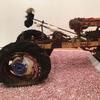Maya Lin's 'Ghost Forest' Takes a Stand In Manhattan's Madison Square Park
- May 11, 2021 12:56

After a delay due to COVID-19 precautions, Maya Lin’s Ghost Forest, a towering stand of forty-nine spectral cedar trees, is a powerful new public art work on view in New York's Madison Square Park, now through November 14, 2021. Killed by saltwater infiltration in New Jersey’s Pine Barrens, the trees were "resurrected" by the artist in the city park, juxtaposed against lush greenspace and ringed by the urban setting. A related soundscape is available online.
The installation builds on Lin’s practice of addressing species loss, habitat loss, and climate change within her work and serves as a call to action to the thousands of visitors who pass through the park daily.

Ghost Forest derives its name from the eponymous natural phenomenon: vast tracts of forestland that have died off due to extreme weather events related to climate change.
A series of virtual public events as well as in-person, socially distanced programs at the park complement the installation. These include the soundscape composed by Lin in collaboration with the Cornell Lab of Ornithology that weaves together the calls and songs of some of the native animal species once common to Manhattan. Lectures on climate change with leading specialists are being held in collaboration with Fotografiska New York and meditative music performances, curated by Carnegie Hall and inspired by nature, are being within the installation throughout the summer. The project culminates in the fall with the planting of 1,000 native trees and shrubs in public natural area parks throughout each of New York City’s five boroughs, a partnership with Natural Areas Conservancy
“Throughout the world, climate change is causing vast tracts of forested lands to die off,” said Lin in her artist’s statement. “They are being called ghost forests; they are being killed off by rising temperatures, extreme weather events that yield saltwater intrusion, forest fires, and insects whose populations are thriving in these warmer temperatures, and trees that are more susceptible to beetles due to being overstressed from these rising temperatures."
“In southwestern Colorado where my family and I live in the summer, these forests—killed off by beetles—are all around us, said Lin. "As I approached thinking about a sculptural installation for Madison Square Park, I knew I wanted to create something that would be intimately related to the Park itself, the trees, and the state of the earth.”
The Conservancy is also dedicating its annual public art symposium to exploring key issues raised by Ghost Forest. Held on June 4, the dynamic virtual event Greening Public Art is anchored by a keynote conversation with Maya Lin, Maria Rodale of the Rodale Institute, and Bill Ulfelder of The Nature Conservancy in New York, moderated by Andrew Revkin of Columbia University’s Earth Institute.

Atlantic white cedars were once plentiful on the East Coast, but their population has dwindled to below 50,000 acres because of historic forestry practices as well as the threats posed from climate change. The 49 cedar trees installed in the park were all slated to be cleared as part of regeneration efforts. In the park, visitors are able to wander through the trees, which are organically interspersed in a dense cluster and stand 40 to 45 feet high. The installation brings the dire reality of this phenomenon to audiences in a dense urban environment and encourages a consideration of nature-based practices that can protect and restore the ecosystem.


















![Peter Paul Rubens (Flemish, 1577–1640), After Titian (Tiziano Vecelli) (Italian [Venetian], c. 1488–1576), Rape of Europa, 1628–29. Oil on canvas, 71 7/8 x 79 3/8 in. Peter Paul Rubens (Flemish, 1577–1640), After Titian (Tiziano Vecelli) (Italian [Venetian], c. 1488–1576), Rape of Europa, 1628–29. Oil on canvas, 71 7/8 x 79 3/8 in.](/images/c/e2/2e/Jan20_Rape_of_Europa100x100_c.jpg)



